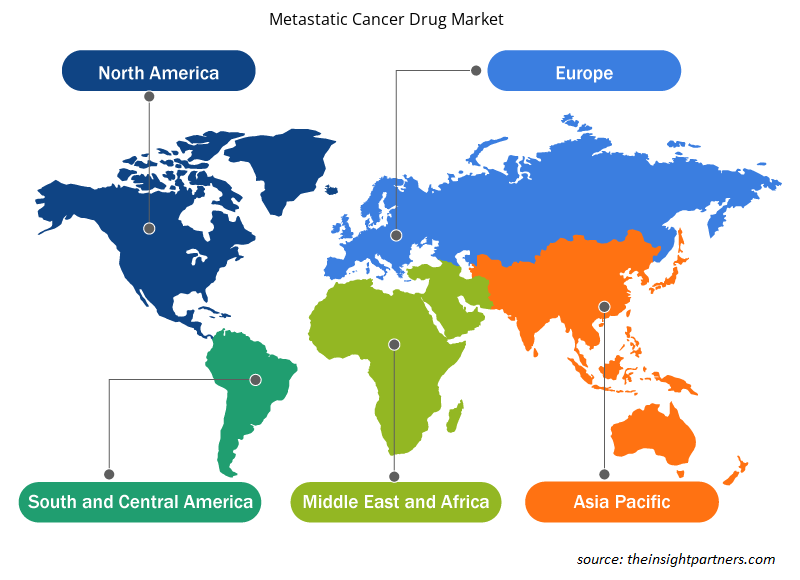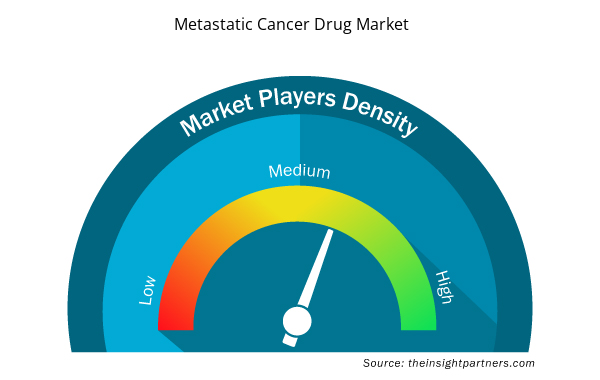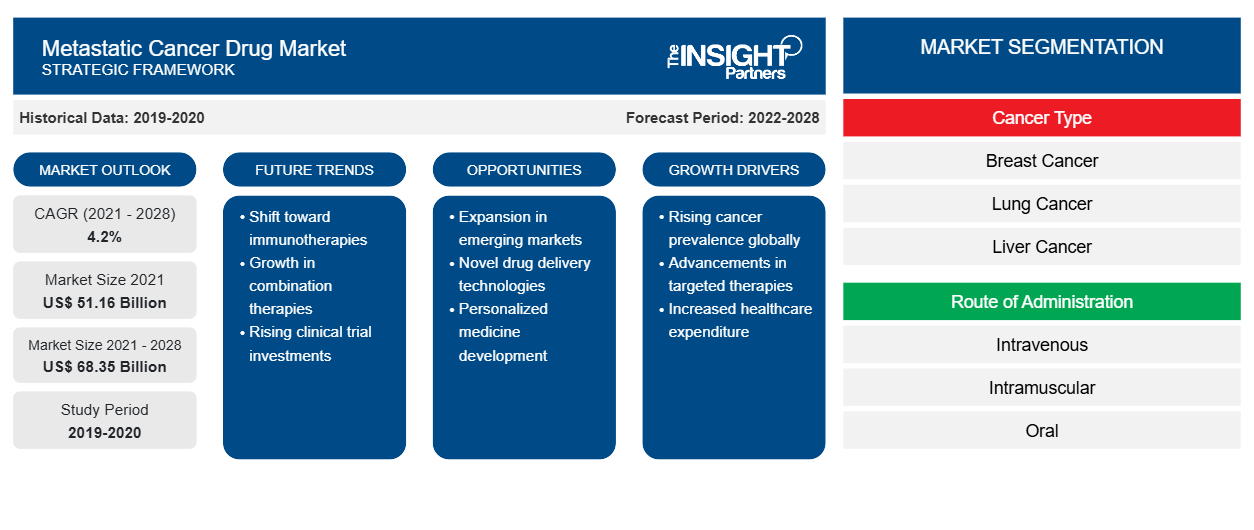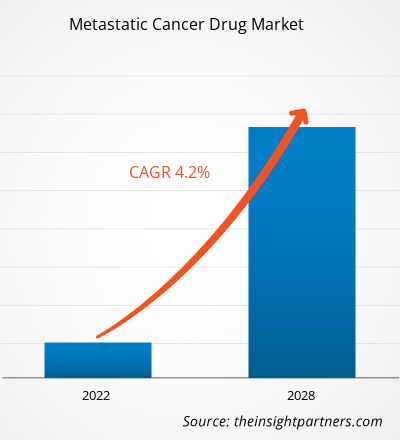[研究报告] 转移性癌症药物市场规模预计将从 2021 年的 511.5797 亿美元增至 2028 年的 683.4954 亿美元。预计 2021 年至 2028 年的复合年增长率为 4.2%。
转移性癌症是指扩散至身体其他部位的晚期癌症,用于治疗晚期癌症的药物被称为转移性癌症药物。这些药物可通过各种疗法使用,例如化疗、免疫疗法和靶向疗法。
转移性癌症药物市场分析基于癌症类型、给药途径、药物类别、产品、最终用户和地理位置。按地理位置划分,市场大致分为北美、欧洲、亚太地区、中东和非洲以及南美和中美洲。该报告提供了对市场的深入分析和见解,强调了转移性癌症药物市场规模、趋势、技术进步和市场动态等参数,以及对全球领先市场参与者的竞争格局的分析。
定制此报告以满足您的需求
您可以免费定制任何报告,包括本报告的部分内容、国家级分析、Excel 数据包,以及为初创企业和大学提供优惠和折扣
- 获取此报告的关键市场趋势。这个免费样品将包括数据分析,从市场趋势到估计和预测。
转移性癌症药物市场的增长得益于转移性癌症的高发性和政府支持癌症治疗发展的举措。然而,肿瘤药物的高成本限制了转移性癌症药物市场的增长。
市场洞察
转移性癌症患病率高
癌症是影响全球社会的重大健康问题之一。根据美国国家癌症研究所提供的数据,2020 年,美国有 1,806,590 人患癌症,606,520 人死于癌症。根据美国癌症研究所的数据,2020 年全球有 18,100 例癌症病例。此外,世界卫生组织 (WHO) 表示,全球有 10,000 人(即六分之一的死亡)死于癌症。最常见的癌症类型是肺癌、乳腺癌、结肠癌、直肠癌和前列腺癌。每年有 400,000 名儿童患上这种疾病。2018 年,全球 13% 的癌症病例是由致癌感染引起的,包括幽门螺杆菌、乙型肝炎病毒、人乳头瘤病毒 (HPV)、丙型肝炎病毒和爱泼斯坦-巴尔病毒。国际癌症研究机构 (IARC) 预测,到 2040 年,全球新发癌症病例和癌症相关死亡人数将从 2018 年的 1640 万增长 1.6-1.7 倍,达到 2950 万。此外,根据美国临床肿瘤学会的数据,2021 年,美国有 290,560 人(287,850 名女性和 2,710 名男性)被诊断出患有浸润性乳腺癌。女性乳腺癌现已超过肺癌,被公认为全球最常见的癌症类型。2020 年,约有 2,261,419 名女性被诊断出患有乳腺癌。
在过去几十年中,美国关于癌症的所有观察记录中,有一项统计数据始终未变——转移性癌症每年占所有癌症死亡人数的 90%。这些数字促使医生和研究人员寻找治疗转移的新方法,转移是指癌症扩散到原发点之外。在美国,6% 的女性在第一次诊断时就被诊断出患有转移性乳腺癌。转移性癌症患病率的上升推动了转移性癌症药物市场的增长。
在北美,加拿大预计在预测期内将出现显著增长。加拿大使用的主要免疫治疗药物是伊匹单抗 (Yervoy)、派姆单抗 (Keytruda)、纳武单抗 (Opdivo)、度伐单抗 (Imfinzi) 和阿替利珠单抗 (Tecentriq)。然而,还有其他检查点抑制剂有望带来整体市场增长。
基于癌症类型的见解
根据癌症类型,转移性癌症药物市场细分为乳腺癌、肺癌、肝癌、血液癌、脑癌、前列腺癌、胰腺癌等。乳腺癌领域在 2021 年占据了最大的市场份额,预计在预测期内将实现最高的复合年增长率。
基于给药途径的见解
根据给药途径,转移性癌症药物市场分为静脉注射、肌肉注射、口服和其他方式。静脉注射部分在 2021 年占据了最大的市场份额,预计在预测期内将实现最高的复合年增长率。
基于药物类别的见解
根据药物类别,转移性癌症药物市场细分为 HER2 抑制剂、免疫检查点抑制剂、PARP 抑制剂、激酶抑制剂等。PARP 抑制剂部分在 2021 年占据了最大的市场份额。然而,HER2 抑制剂部分预计在预测期内将实现最高的复合年增长率。
转移性癌症药物市场区域洞察
Insight Partners 的分析师已详细解释了预测期内影响转移性癌症药物市场的区域趋势和因素。本节还讨论了北美、欧洲、亚太地区、中东和非洲以及南美和中美洲的转移性癌症药物市场细分和地理位置。

- 获取转移性癌症药物市场的区域特定数据
转移性癌症药物市场报告范围
| 报告属性 | 细节 |
|---|---|
| 2021 年市场规模 | 511.6亿美元 |
| 2028 年市场规模 | 683.5亿美元 |
| 全球复合年增长率(2021 - 2028) | 4.2% |
| 史料 | 2019-2020 |
| 预测期 | 2022-2028 |
| 涵盖的领域 | 按癌症类型
|
| 覆盖地区和国家 | 北美
|
| 市场领导者和主要公司简介 |
|
转移性癌症药物市场参与者密度:了解其对业务动态的影响
转移性癌症药物市场正在快速增长,这得益于终端用户需求的不断增长,而这些需求又源于消费者偏好的不断变化、技术进步以及对产品优势的认识不断提高等因素。随着需求的增加,企业正在扩大其产品范围,进行创新以满足消费者的需求,并利用新兴趋势,从而进一步推动市场增长。
市场参与者密度是指在特定市场或行业内运营的企业或公司的分布情况。它表明在给定市场空间中,相对于其规模或总市场价值,有多少竞争对手(市场参与者)存在。
在转移性癌症药物市场运营的主要公司有:
- 艾伯维公司(AbbVie Inc.)
- 安进公司
- 百时美施贵宝公司
- F.霍夫曼-拉罗氏有限公司
- 诺华公司
免责声明:上面列出的公司没有按照任何特定顺序排列。

- 了解转移性癌症药物市场顶级关键参与者概况
基于产品的洞察
根据产品,转移性癌症药物市场分为品牌药、仿制药和生物仿制药。品牌药部分在 2021 年占据了更大的市场份额。然而,仿制药和生物仿制药部分预计在预测期内的复合年增长率更高。
基于最终用户的洞察
根据最终用户,转移性癌症药物市场分为医院、专科诊所和其他。医院部分在 2021 年占最大份额,而专科诊所部分预计在预测期内实现最高复合年增长率。
产品发布和批准是公司扩大全球影响力和产品组合的常用策略之一。转移性癌症药物市场参与者还专注于合作战略以扩大客户群,这反过来又使他们能够在全球范围内保持自己的品牌名称。他们的目标是通过开发创新产品来扩大市场份额。
AbbVie Inc.;Amgen Inc.;Bristol-Myers Squibb Company;F. HOFFMANN-LA ROCHE LTD.;Novartis AG;ASTRAZENECA PLC.;Eli Lilly and Company;MERCK KGaA;Pfizer Inc. (Arena Pharmaceutical GmbH);以及 Johnson and Johnson Services, Inc. 是转移性癌症药物市场的领先公司。
- 历史分析(2 年)、基准年、预测(7 年)及复合年增长率
- PEST 和 SWOT 分析
- 市场规模价值/数量 - 全球、区域、国家
- 行业和竞争格局
- Excel 数据集



Report Coverage
Revenue forecast, Company Analysis, Industry landscape, Growth factors, and Trends

Segment Covered
This text is related
to segments covered.

Regional Scope
North America, Europe, Asia Pacific, Middle East & Africa, South & Central America

Country Scope
This text is related
to country scope.
常见问题
Cancer that spreads from where it started to a distant part of the body is called metastatic cancer. The process by which cancer cells spread to other parts of the body is called metastasis. Metastatic cancer is an advanced cancer stage that spread to the other body parts and the drugs used for the treatment of advanced stage cancer are known as metastatic cancer drugs. These drugs are used through various therapies such as chemotherapy, immunotherapy, and targeted therapy.
The factors that are driving and restraining factors that will affect the metastatic cancer drugs market in the coming years. The growth of the market is attributed to some key driving factors such as increasing prevalence of cancer and government initiatives to support drug developments for cancer treatment. However, high cost of oncology drugs is likely to hinder the market growth.
The metastatic cancer drug market, by cancer type, is bifurcated into breast cancer, lung cancer, liver cancer, hematological cancer, brain cancer, prostate cancer, pancreatic cancer, and others. The breast cancer segment held the largest share in 2021 and is anticipated to register the highest CAGR during the forecast period.
The metastatic cancer drug market majorly consists of the players such as AbbVie Inc., Amgen Inc., Bristol-Myers Squibb Company, F. HOFFMANN-LA ROCHE LTD., Novartis AG, ASTRAZENECA PLC., Eli Lilly and Company, MERCK KGaA, and Pfizer Inc. (Arena Pharmaceutical GmbH) amongst others.
Trends and growth analysis reports related to Life Sciences : READ MORE..
The List of Companies - Metastatic Cancer Drug Market
- AbbVie Inc.
- Amgen Inc.
- Bristol-Myers Squibb Company
- F. HOFFMANN-LA ROCHE LTD.
- Novartis AG
- ASTRAZENECA PLC.
- Eli Lilly and Company
- MERCK KGaA
- Pfizer Inc. (Arena Pharmaceutical GmbH)
The Insight Partners performs research in 4 major stages: Data Collection & Secondary Research, Primary Research, Data Analysis and Data Triangulation & Final Review.
- Data Collection and Secondary Research:
As a market research and consulting firm operating from a decade, we have published and advised several client across the globe. First step for any study will start with an assessment of currently available data and insights from existing reports. Further, historical and current market information is collected from Investor Presentations, Annual Reports, SEC Filings, etc., and other information related to company’s performance and market positioning are gathered from Paid Databases (Factiva, Hoovers, and Reuters) and various other publications available in public domain.
Several associations trade associates, technical forums, institutes, societies and organization are accessed to gain technical as well as market related insights through their publications such as research papers, blogs and press releases related to the studies are referred to get cues about the market. Further, white papers, journals, magazines, and other news articles published in last 3 years are scrutinized and analyzed to understand the current market trends.
- Primary Research:
The primarily interview analysis comprise of data obtained from industry participants interview and answers to survey questions gathered by in-house primary team.
For primary research, interviews are conducted with industry experts/CEOs/Marketing Managers/VPs/Subject Matter Experts from both demand and supply side to get a 360-degree view of the market. The primary team conducts several interviews based on the complexity of the markets to understand the various market trends and dynamics which makes research more credible and precise.
A typical research interview fulfils the following functions:
- Provides first-hand information on the market size, market trends, growth trends, competitive landscape, and outlook
- Validates and strengthens in-house secondary research findings
- Develops the analysis team’s expertise and market understanding
Primary research involves email interactions and telephone interviews for each market, category, segment, and sub-segment across geographies. The participants who typically take part in such a process include, but are not limited to:
- Industry participants: VPs, business development managers, market intelligence managers and national sales managers
- Outside experts: Valuation experts, research analysts and key opinion leaders specializing in the electronics and semiconductor industry.
Below is the breakup of our primary respondents by company, designation, and region:

Once we receive the confirmation from primary research sources or primary respondents, we finalize the base year market estimation and forecast the data as per the macroeconomic and microeconomic factors assessed during data collection.
- Data Analysis:
Once data is validated through both secondary as well as primary respondents, we finalize the market estimations by hypothesis formulation and factor analysis at regional and country level.
- Macro-Economic Factor Analysis:
We analyse macroeconomic indicators such the gross domestic product (GDP), increase in the demand for goods and services across industries, technological advancement, regional economic growth, governmental policies, the influence of COVID-19, PEST analysis, and other aspects. This analysis aids in setting benchmarks for various nations/regions and approximating market splits. Additionally, the general trend of the aforementioned components aid in determining the market's development possibilities.
- Country Level Data:
Various factors that are especially aligned to the country are taken into account to determine the market size for a certain area and country, including the presence of vendors, such as headquarters and offices, the country's GDP, demand patterns, and industry growth. To comprehend the market dynamics for the nation, a number of growth variables, inhibitors, application areas, and current market trends are researched. The aforementioned elements aid in determining the country's overall market's growth potential.
- Company Profile:
The “Table of Contents” is formulated by listing and analyzing more than 25 - 30 companies operating in the market ecosystem across geographies. However, we profile only 10 companies as a standard practice in our syndicate reports. These 10 companies comprise leading, emerging, and regional players. Nonetheless, our analysis is not restricted to the 10 listed companies, we also analyze other companies present in the market to develop a holistic view and understand the prevailing trends. The “Company Profiles” section in the report covers key facts, business description, products & services, financial information, SWOT analysis, and key developments. The financial information presented is extracted from the annual reports and official documents of the publicly listed companies. Upon collecting the information for the sections of respective companies, we verify them via various primary sources and then compile the data in respective company profiles. The company level information helps us in deriving the base number as well as in forecasting the market size.
- Developing Base Number:
Aggregation of sales statistics (2020-2022) and macro-economic factor, and other secondary and primary research insights are utilized to arrive at base number and related market shares for 2022. The data gaps are identified in this step and relevant market data is analyzed, collected from paid primary interviews or databases. On finalizing the base year market size, forecasts are developed on the basis of macro-economic, industry and market growth factors and company level analysis.
- Data Triangulation and Final Review:
The market findings and base year market size calculations are validated from supply as well as demand side. Demand side validations are based on macro-economic factor analysis and benchmarks for respective regions and countries. In case of supply side validations, revenues of major companies are estimated (in case not available) based on industry benchmark, approximate number of employees, product portfolio, and primary interviews revenues are gathered. Further revenue from target product/service segment is assessed to avoid overshooting of market statistics. In case of heavy deviations between supply and demand side values, all thes steps are repeated to achieve synchronization.
We follow an iterative model, wherein we share our research findings with Subject Matter Experts (SME’s) and Key Opinion Leaders (KOLs) until consensus view of the market is not formulated – this model negates any drastic deviation in the opinions of experts. Only validated and universally acceptable research findings are quoted in our reports.
We have important check points that we use to validate our research findings – which we call – data triangulation, where we validate the information, we generate from secondary sources with primary interviews and then we re-validate with our internal data bases and Subject matter experts. This comprehensive model enables us to deliver high quality, reliable data in shortest possible time.


 获取此报告的免费样本
获取此报告的免费样本